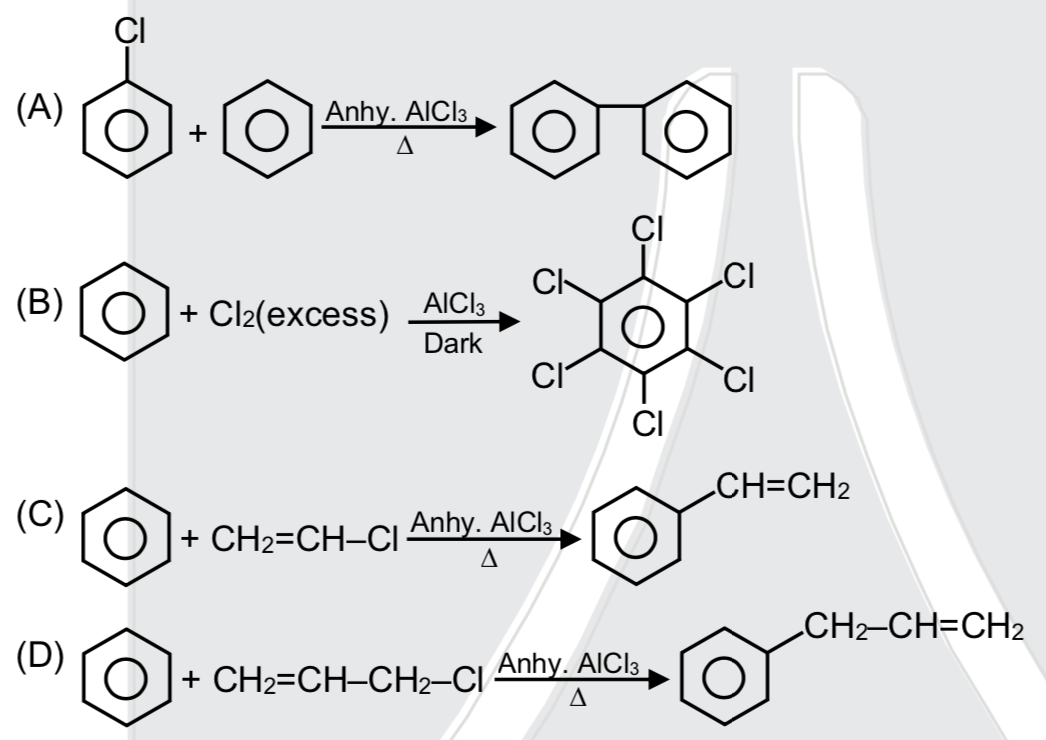Which reaction is/are possible?
MgCl2+NaNO3→
BaSO4+HCl→
ZnSO4+BaS→
BaCO3+CH3COOH→
The correct Answer is:C, D
To determine which reactions are possible among the given combinations of reactants, we will analyze each option step by step.
Step 1: Analyze Magnesium Chloride and Sodium Nitrate
- Reactants: Magnesium Chloride (MgCl2) + Sodium Nitrate (NaNO3)
- Analysis: Magnesium Chloride is soluble in water, and Sodium Nitrate is also soluble. However, there is no significant reaction between these two compounds as they do not form any precipitate or gas.
- Conclusion: No reaction occurs.
Step 2: Analyze Barium Sulfate and Hydrochloric Acid
- Reactants: Barium Sulfate (BaSO4) + Hydrochloric Acid (HCl)
- Analysis: Barium Sulfate is insoluble in water and does not react with hydrochloric acid. Therefore, there is no reaction.
- Conclusion: No reaction occurs.
Step 3: Analyze Zinc Sulfate and Barium Sulfide
- Reactants: Zinc Sulfate (ZnSO4) + Barium Sulfide (BaS)
- Analysis: When these two react, they undergo a double displacement reaction, resulting in the formation of Zinc Sulfide (ZnS) and Barium Sulfate (BaSO4). Both products are insoluble in water and will precipitate out.
- Conclusion: Reaction occurs, producing ZnS and BaSO4.
Step 4: Analyze Barium Carbonate and Acetic Acid
- Reactants: Barium Carbonate (BaCO3) + Acetic Acid (CH3COOH)
- Analysis: Barium Carbonate reacts with Acetic Acid to produce Barium Acetate (Ba(CH3COO)2), Carbon Dioxide (CO2), and Water (H2O). The reaction produces gas (CO2), indicating that it is a valid reaction.
- Conclusion: Reaction occurs, producing Ba(CH3COO)2, CO2, and H2O.
Final Summary of Possible Reactions
- Possible Reactions:
- Zinc Sulfate + Barium Sulfide → ZnS + BaSO4
- Barium Carbonate + Acetic Acid → Ba(CH3COO)2 + CO2 + H2O
- Not Possible Reactions:
- Magnesium Chloride + Sodium Nitrate
- Barium Sulfate + Hydrochloric Acid
Answer
The possible reactions are:
- Option C: Zinc Sulfate + Barium Sulfide
- Option D: Barium Carbonate + Acetic Acid
- Reactants: Magnesium Chloride (MgCl2) + Sodium Nitrate (NaNO3)
- Analysis: Magnesium Chloride is soluble in water, and Sodium Nitrate is also soluble. However, there is no significant reaction between these two compounds as they do not form any precipitate or gas.
- Conclusion: No reaction occurs.
- Reactants: Barium Sulfate (BaSO4) + Hydrochloric Acid (HCl)
- Analysis: Barium Sulfate is insoluble in water and does not react with hydrochloric acid. Therefore, there is no reaction.
- Conclusion: No reaction occurs.
- Reactants: Zinc Sulfate (ZnSO4) + Barium Sulfide (BaS)
- Analysis: When these two react, they undergo a double displacement reaction, resulting in the formation of Zinc Sulfide (ZnS) and Barium Sulfate (BaSO4). Both products are insoluble in water and will precipitate out.
- Conclusion: Reaction occurs, producing ZnS and BaSO4.
- Reactants: Barium Carbonate (BaCO3) + Acetic Acid (CH3COOH)
- Analysis: Barium Carbonate reacts with Acetic Acid to produce Barium Acetate (Ba(CH3COO)2), Carbon Dioxide (CO2), and Water (H2O). The reaction produces gas (CO2), indicating that it is a valid reaction.
- Conclusion: Reaction occurs, producing Ba(CH3COO)2, CO2, and H2O.
- Possible Reactions:
- Zinc Sulfate + Barium Sulfide → ZnS + BaSO4
- Barium Carbonate + Acetic Acid → Ba(CH3COO)2 + CO2 + H2O
- Not Possible Reactions:
- Magnesium Chloride + Sodium Nitrate
- Barium Sulfate + Hydrochloric Acid
The possible reactions are:
- Option C: Zinc Sulfate + Barium Sulfide
- Option D: Barium Carbonate + Acetic Acid
Topper's Solved these Questions
- QUALITATIVE INORGANIC ANALYSISBOOK - VK JAISWAL ENGLISHCHAPTER - QUALITATIVE INORGANIC ANALYSISEXERCISE - MATCH THE COLUMN
4 Videos
- QUALITATIVE INORGANIC ANALYSISBOOK - VK JAISWAL ENGLISHCHAPTER - QUALITATIVE INORGANIC ANALYSISEXERCISE - ASSERTION-REASON TYPE QUESTIONS
14 Videos
- QUALITATIVE INORGANIC ANALYSISBOOK - VK JAISWAL ENGLISHCHAPTER - QUALITATIVE INORGANIC ANALYSISEXERCISE - LEVEL 3
62 Videos
- PERIODIC PROPERTIESBOOK - VK JAISWAL ENGLISHCHAPTER - PERIODIC PROPERTIESEXERCISE - MATCH THE COLUMN
11 Videos
- s-BLOCK ELEMENTSBOOK - VK JAISWAL ENGLISHCHAPTER - s-BLOCK ELEMENTSEXERCISE - SUBJECTIVE PROBLEMS
2 Videos
Similar Questions
Knowledge Check
Which reaction is not possible for acetic anhydride ?
A⎛⎜ ⎜⎝CH3O∣∣C⎞⎟ ⎟⎠2O+2HN(CH3)2→CH3O∣∣CN(CH3)2+CH3CO−2+H2+N(CH3)2B⎛⎜ ⎜⎝CH3O∣∣C⎞⎟ ⎟⎠2O+CH3CH2OH→CH3O∣∣COCH2CH3+CH3CO2HC⎛⎜ ⎜⎝CH3O∣∣C⎞⎟ ⎟⎠2O+C6H6AlCl3−−→CH3O∣∣CC6H5+CH3CO2HD⎛⎜ ⎜⎝CH3O∣∣C⎞⎟ ⎟⎠2O+NaCl→CH3O∣∣CCl+CH3CO−2Na+Which of the following reaction is possible ?
AC6H5OH+HBr→C6H5Br+H2OB(CH3)3CCl+NaOCH3→(CH3)3COCH3+NaClC D
D
Which of the following reaction is possible ?
AC6H5OH+HBr→C6H5Br+H2OB(CH3)3CCl+NaOCH3→(CH3)3COCH3+NaClC D
D
An accelerated electron is absorbed by a proton at rest and a neutron is formed. Write the reaction equation. Assuming that the resulting neutron remains at rest, calculate the minimum kinetic energy of the electron at which the reaction is possible.
View SolutionWhich of the following reactions are possible ?

View SolutionWhich of the following reactions are possible ?

View Solutionwhich of these nuclear reaction is possible?
View SolutionWhich of the following reaction is possible ?
View Solution
